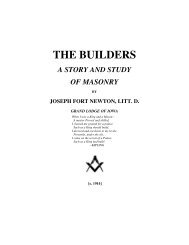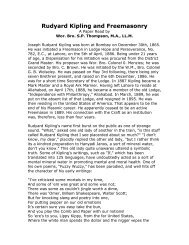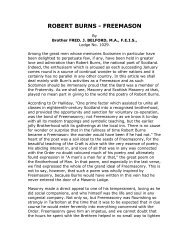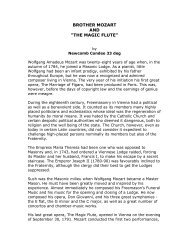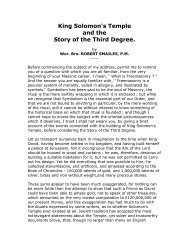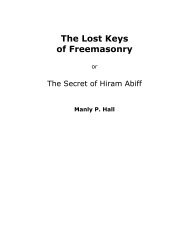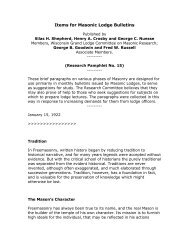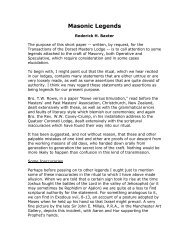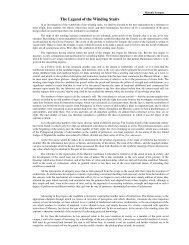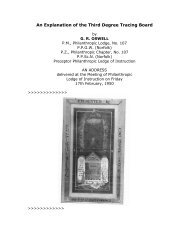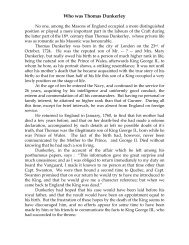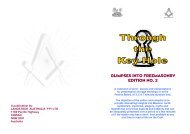You also want an ePaper? Increase the reach of your titles
YUMPU automatically turns print PDFs into web optimized ePapers that Google loves.
embellish it with two rosettes at the bottom, and when he becomes a<br />
Master Mason he may add a third rosette, line and edge it with silk of<br />
that colour adopted by his Lodge, and further adorn it by adding<br />
tassels. The origin of tassels and rosettes has given rise to<br />
considerable discussion. It has been suggested that the tassels have<br />
been evolved from the two long ribbons by which early aprons were<br />
girt about the body. These ribbons passed round the waist and were<br />
tied under the flap, with the ends pendant in front. The ends were<br />
ornamented with a silver fringe, and had become so characteristic<br />
that, when the strap and buckle arrangement was devised, they were<br />
retained, being gathered up into the form of tassels and placed one on<br />
either side. No satisfactory explanation of the origin of rosettes has<br />
been furnished. One theory is that they represent the point within the<br />
circle with which all Freemasons are familiar, but it is not generally<br />
accepted. Other details, always in the way of more elaborate<br />
decoration, are added according to the taste of the wearer. Sometimes<br />
the rosette bears a five-pointed star in relief. Occasionally the flap is<br />
embellished with the compasses and square and the sacred symbol in<br />
the centre. Now and again we find it ornamented with the Sun, the<br />
Moon, the Seven Stars, and the All-Seeing Eye. There does not appear<br />
to be any limit to the scheme of decoration which a brother may adopt<br />
so long as he confines himself to purely Masonic symbols. Office, of<br />
course, carried with it, its own ornaments. The apron of every officebearer<br />
should display the particular jewel of his office; and in the case<br />
of a R.W.M. or P.M. the two rosettes at the bottom are replaced with<br />
levels of inverted “T<strong>au</strong>s” while the rosette on the flap gives way to the<br />
compasses and square enclosing the Sun and resting upon the<br />
segment of a circle, all which denote the rank of the brother.<br />
But, no matter what the decoration or the rank it denotes every<br />
brother — even the Grand Master upon whose honoured shoulders<br />
rests the purple of the fraternity — must bear in mind that no<br />
adornment can add anything to the moral grandeur of the symbol, and<br />
that the badge of a Mason is found not in fine gold nor in silken fabric,<br />
but in the pure and spotless surface of the lambskin which is the<br />
common mark — as it should be the common object of veneration —<br />
of every member of our ancient and honourable fraternity.<br />
The thoughtful Freemason who lingers over the charge which is<br />
addressed to him at his investiture cannot fail to appreciate that the<br />
apron is an emblem of all that is highest and best in human life. Bro.<br />
W. Harry Rylands, in an article on “The Masonic Apron,” which he<br />
contributed to the “Transactions of the Lodge Quatuor Coronati,” says<br />
that he has found nothing which would lead him to believe that much



